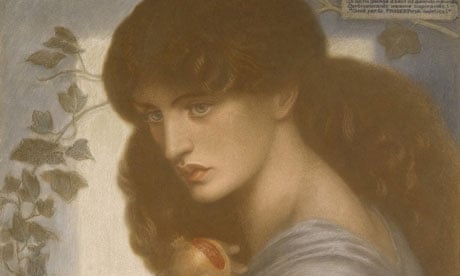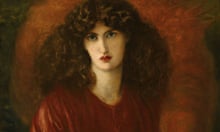On the evidence of one of the last paintings completed by the Pre-Raphaelite artist Dante Gabriel Rossetti, he never got over his best friend's wife. His glowing picture of Janey Morris, portrayed as Proserpine with an expression of ambiguous yearning, is to go on sale with a price tag estimated at up to £1.8m.
The picture is described by Sotheby's, which will auction it in November, as "one of the defining images of European art – instantly recognisable and representing the artist at the height of his originality". The last time the chalk drawing was sold it went for £4,500, regarded as a pretty good price in 1970, when the swoony Pre-Raphaelites looked distinctly old fashioned.
Now after a string of significant shows including the Tate exhibition currently on display at the Pushkin museum in Moscow, and a television series following the Pre-Raphaelite artists' tangled lives and loves, the picture is expected to do dramatically better.
The beautiful Janey Burden, daughter of a groom in an Oxford stableyard, was being trained for domestic service when she was taken up by the artists, who regarded her long sad face, great dark eyes and mass of curling hair as their ideal of feminine beauty. William Morris fell in love with her, paid for her private education, and married her in 1859. She modelled for most of the group but Rossetti became seriously smitten, causing Morris anguish, although their marriage lasted until his death in 1896.
Rossetti returned to the subject of Proserpine repeatedly in his last years, and Simon Toll, a specialist in British and Irish art at Sotheby's, thinks the smoky chalk drawing is the most perfectly realised of all these late versions. Another version is in the Tate collection, while a further version was bought by the painter LS Lowry.
Rossetti's very last painting, which was completed a few months before his death in April 1882 at the age of 53, also depicted Janey.
The chalk drawing shows her as Proserpine, the goddess of spring, stolen by the god of the underworld and reclaimed by her mother, but condemned by the three pomegranate seeds she had eaten to spend three months of every year in the underworld. In the picture she stands half in sunlight, half in shadow, the fateful pomegranate in her hand.
"Their ambiguous relationship is all there in the painting," Toll said. "He couldn't keep her, he couldn't let her go. It was almost an addiction. He never got over her."
The picture was first bought by one of the artist's great patrons, William Graham, a Glasgow MP who eventually owned 37 Rossetti paintings. The present owner, possibly inspired by his friend LS Lowry's love for Rossetti, bought it from the Stone Gallery in Newcastle upon Tyne, which became renowned for sticking with the Pre-Raphaelites no matter how far they fell out of fashion.
"I knew of some of his paintings but I didn't realise he had Proserpine. When I walked into his room, and saw it just hanging on the wall of a perfectly ordinary house, not a mansion, my legs nearly went from under me. It has never been hung in the light, never injudiciously cleaned, it is immaculate, a wonderful thing."



